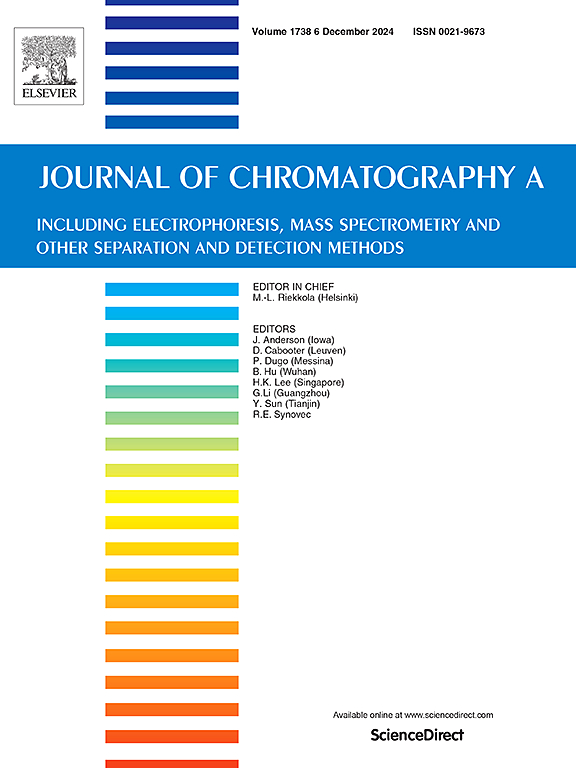流线定向可调确定性横向位移芯片:高效颗粒分离的数值方法
IF 4
2区 化学
Q1 BIOCHEMICAL RESEARCH METHODS
引用次数: 0
摘要
在传统的确定性侧向位移(DLD)中,特定尺寸颗粒的迁移行为由临界直径(Dc)决定,而临界直径是由设备的几何形状预先确定的。典型的方法是通过修改几何参数来改变支柱阵列与流体流线之间的角度,与此不同的是,本研究引入了一种新的视角,重点在于改变流线的方向。所提出的技术提供了一种可调 DLD 芯片,其设计简单明了,易于制造。该芯片采用一个完全水平的支柱阵列,在 DLD 腔体的顶部和底部设有两个旁路通道。这些旁路通道的宽度从入口到出口呈线性变化。为这种芯片提出了两种设计配置,其特点是旁路通道的坡度平行或不平行。通过操纵两个不同的控制参数,该芯片能够产生较大范围的 Dc 值。第一个控制参数涉及调整两个旁路通道的流速。第二个控制参数涉及控制这些旁路通道的斜率。这两个参数都会影响颗粒携带流线的方向,从而改变颗粒的路径线。通过改变流线与支柱阵列的角度,可以调整 Dc。在确定每种情况的 Dc 值之前,使用 Python 脚本利用流线坐标进行了初步估算。随后,通过对粒子轨迹进行有限元建模,确定了精确的 Dc 值,并将其与估计值进行比较,结果显示差异极小。通过调整旁路通道的流速和坡度,最大 Dc 值范围可分别达到 4-10 μm 和 8-13 μm。这种创新型芯片可实现 0.5 至 14 μm 的 Dc 值。本文章由计算机程序翻译,如有差异,请以英文原文为准。
Streamline-directed tunable deterministic lateral displacement chip: A numerical approach to efficient particle separation
In conventional Deterministic Lateral Displacement (DLD), the migration behavior of a particle of specific size is determined by the critical diameter (Dc), which is predefined by the device's geometry. In contrast to the typical approach that alters the angle between the pillar array and fluid streamlines by modifying the geometrical parameters, this study introduces a novel perspective that focuses on changing the direction of the streamlines. The proposed technique offers a tunable DLD chip featuring a straightforward design that allows for easy fabrication. This chip features one completely horizontal pillar array with two bypass channels on the top and bottom of the DLD chamber. The width of these bypass channels changes linearly from their inlet to their outlet. Two design configurations are suggested for this chip, characterized by either parallel or unparallel slopes of the bypass channels. This chip is capable of generating a wide range of Dc values by manipulating two distinct control parameters. The first control parameter involves adjusting the flow rates in the two bypass channels. The second control parameter entails controlling the slopes of these bypass channels. Both of these parameters influence the direction of particle-carrying streamlines resulting in a change in the path-line of the particles. By changing the angle of streamlines with pillar array, the Dc can be tuned. Prior to determining the Dc for each case, an initial estimation was made using a Python script that utilized the streamline coordinates. Subsequently, through FEM modeling of the particle trajectories, precise Dc values were ascertained and compared with the estimated values, revealing minimal disparities. By adjusting the flow rate and slope of the bypass channels, maximum Dc ranges of 4–10 μm and 8–13 μm can be achieved, respectively. This innovative chip enables the attainment of Dc values spanning from 0.5 to 14 μm.
求助全文
通过发布文献求助,成功后即可免费获取论文全文。
去求助
来源期刊

Journal of Chromatography A
化学-分析化学
CiteScore
7.90
自引率
14.60%
发文量
742
审稿时长
45 days
期刊介绍:
The Journal of Chromatography A provides a forum for the publication of original research and critical reviews on all aspects of fundamental and applied separation science. The scope of the journal includes chromatography and related techniques, electromigration techniques (e.g. electrophoresis, electrochromatography), hyphenated and other multi-dimensional techniques, sample preparation, and detection methods such as mass spectrometry. Contributions consist mainly of research papers dealing with the theory of separation methods, instrumental developments and analytical and preparative applications of general interest.
 求助内容:
求助内容: 应助结果提醒方式:
应助结果提醒方式:


